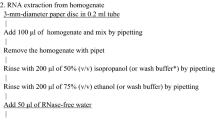Summary
A reverse trancription-polymerase chain reaction (RT-PCR) assay was devised and shown to be sensitive and reliable for the detection of potato mop-top virus (PMTV) RNA sequences in the flesh of virus infected potato tubers, and in the roots and leaves of soil-bait plants. This assay was compared with an enzyme-linked immunosorbent assay incorporating PMTV specific monoclonal antibodies (TAS-ELISA). The tests were devised to improve the efficiency of detection of viruliferousSpongospora subterranea in agricultural soils, and PMTV in potato tubers. RT-PCR detected PMTV RNA sequences in the roots and leaves of bait plants after three weeks growth in viruliferous soil, three weeks before the bait plants themselves developed symptoms, and two weeks before the virus was detected by TAS-ELISA. Both RT-PCR and TAS-ELISA detected PMTV in the tubers of primary-infected potatoes. RT-PCR and TAS-ELISA were shown to be more sensitive and reliable than conventional baittests and sap inoculation methods for the detection and diagnosis of PMTV.
Similar content being viewed by others
References
Barker, H., K.D. Webster & B. Reavy, 1993. Detection of potato virus Y in potato tubers: a comparison of polymerase chain reaction and enzyme-linked immunosorbent assay.Potato Research 36: 13–20.
Beemster, A.B.R. & A. de Heij, 1987. A method for detectingPolymyxa betae and beet necrotic yellow vein virus in soil using sugar-beet as a bait plant.Netherlands Journal of Plant Pathology 93: 91–93.
Calvert, E.L. & B.D. Harrison, 1966. Potato mop-top, a soil-borne virus.Plant Pathology 15: 134–139.
Chen, J., A.G. Swaby, M.J. Adams & R. Yili, 1991. Barley mild mosaic virus inside its fungal vector,Polymyxa graminis.Annals of Applied Biology 118: 615–621.
Dahm, H. & H. Buchenauer, 1993. Studies on the biology ofPolymyxa betae, the vector of beet necrotic yellow vein virus.Journal of Phytopathology 139: 329–338.
Harrison, B.D., 1974. Potato mop-top virus. CMI/AAB Descriptions of Plant Viruses No. 138. In: A.F. Murant & B.D. Harrison (Eds), Association of Applied Biologists, Wellesbourne, UK.
Harrison, B.D. & R.A.C. Jones, 1970. Host range and some properties of potato mop-top virus.Annals of Applied Biology 65: 393–402.
Henson, J.M. & R. French, 1993. The polymerase chain reaction and plant disease diagnosis.Annual Review of Phytopathology 31: 81–109.
Jones, R.A.C., 1988. Epidemiology and control of potato mop-top virus. In: J.I. Cooper & M.J.C. Asher (Eds), Developments in Applied Biology 2: Viruses with Fungal Vectors, Association of Applied Biologists, Wellesbourne, UK, pp. 255–270.
Jones, R.A.C. & B.D. Harrison, 1969. The behaviour of potato mop-top virus in soil, and evidence for its transmission bySpongospora subterranea (Wallr.) Lagerh.Annals of Applied Biology 63: 1–17.
Kurppa, A.H.J., 1989a. Reaction of potato cultivars to primary and secondary infection by potato mop-top furovirus and strategies for virus detection.EPPO Bulletin 19: 593–598.
Kurppa, A.H.J., 1989b. The distribution and incidence of potato mop-top virus in Finland as determined in 1987 and on the variation of disease symptoms in infected potatoes.Annales Agriculturae Fenniae 28: 285–295.
Peters, D. & A. Godfrey-Veltman, 1989.Polymyxa betae zoospores as vectors of beet necrotic yellow vein furovirus.EPPO Bulletin 19: 509–515.
Reavy, B., S. Kashiwazaki, K.P. Scott & B.D. Harrison, 1993. Potato mop-top virus: a third type of furovirus genome organisation. In: C. Hiruki (Ed.), Proceedings of the Second Symposium of the International Working Group on Plant Viruses with Fungal Vectors, American Society of Sugar Beet Technologies, Denver, CO, pp. 23–26.
Rysanek, P., G. Stocky, A.M. Haeberlé & C. Putz, 1992. Immunogold labelling of beet necrotic yellow vein virus particles inside its fungal vector,Polymyxa betae K.Agronomie 12: 651–659.
Torrance, L., 1990. Detection of potato mop-top virus by monoclonal antibodies. Proceedings of Crop Protection in Northern Britain Conference 1990, pp. 199–201.
Torrance, L., 1992. Serological methods to detect plant viruses: production and use of monoclonal antibodies. In: J.M. Duncan & L. Torrance (Eds), Techniques for the Rapid Detection of Plant Pathogens, Blackwell Scientific Publications, Oxford, pp. 7–33.
Torrance, L., G.H. Cowan & L.G. Pereira, 1993. Monoclonal antibodies specific for potato mop-top virus, and some properties of the coat protein.Annals of Applied Biology 122: 311–322.
Torrance, L., G.H. Cowan, K.P. Scott, L.G. Pereira, I.M. Roberts, B. Reavy & B.D. Harrison, 1992. Detection and diagnosis of potato mop-top virus. Annual Report of Scottish Crop Research Institute for 1991, pp. 80–82.
Tuitert, G., 1993. Effect of conditions during storage of infested soil on infection of bait plants byPolymyxa betae and beet necrotic yellow vein virus.Netherlands Journal of Plant Pathology 99: 291–301.
Tuitert, G. & G.J. Bollen, 1993. Recovery of resting spores ofPolymyxa betae from soil and the influence of duration of the bioassay on the detection level of beet necrotic yellow vein virus in soil.Netherlands Journal of Plant Pathology 99: 219–230.
Verwoerd, T.C., B.M.M. Dekker & A. Hoekema, 1989. A small scale procedure for the rapid isolation of plant RNAs.Nucleic Acid Research 17: 2362.
Author information
Authors and Affiliations
Rights and permissions
About this article
Cite this article
Arif, M., Torrance, L. & Reavy, B. Improved efficiency of detection of potato mop-top furovirus in potato tubers and in the roots and leaves of soil-bait plants. Potato Res 37, 373–381 (1994). https://doi.org/10.1007/BF02358351
Accepted:
Issue Date:
DOI: https://doi.org/10.1007/BF02358351




